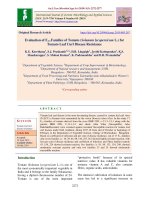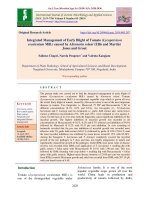Biological management of damping off disease of tomato cause by Pythium aphanidermatum
Bạn đang xem bản rút gọn của tài liệu. Xem và tải ngay bản đầy đủ của tài liệu tại đây (90.26 KB, 4 trang )
Int.J.Curr.Microbiol.App.Sci (2020) 9(5): 2407-2410
International Journal of Current Microbiology and Applied Sciences
ISSN: 2319-7706 Volume 9 Number 5 (2020)
Journal homepage:
Original Research Article
/>
Biological Management of Damping off Disease of Tomato
Cause by Pythium aphanidermatum
B. Bora1* and B. C. Deka2
1
Department of Plant Pathology, Biswanath College of Agriculture,
Biswanath Chariali, Assam, India
2
Krishi Vigyan Kendra, Lakhimpur, Assam, India
*Corresponding author
ABSTRACT
Keywords
Damping off,
Bioveer, Biofor PF2, Biomonas and
Biozin PTB
Article Info
Accepted:
18 April 2020
Available Online:
10 May 2020
Talc based bioformulations namely Biofor PF-2, Bioveer, Biomonas and
Biozin PTB were evaluated against damping off disease of tomato.
Application of these bioformulations as seed treatment and in nursery bed
treatment before sowing significantly reduced the pre- and post-emergence
damping off of tomato. Among all the bioformulations tested, Biozin PTB
was found most effective in reducing maximum (76.68 and 70.76 per cent)
reduction of pre- and post-emergence damping off of tomato. Besides
reducing the pre- and post-emergence damping off, Biozin PTB also caused
maximum increase of root length, shoot length and biomass production of
tomato seedlings.
Introduction
Tomato (Lycopersicon esculentum Mill) is
one of the most popular vegetable crops,
grown all over the country and it is also
widely cultivated in Assam. The crop is
attacked by several diseases, caused by fungi,
bacteria and viruses leading to severe crop
losses. Among the fungal diseases, the
damping off disease incited by Pythium
aphanidermatum is a major constraint in the
production of tomato. Pythium spp. are
essentially soil borne (Berkley, 1925;
Horsfall, 1930) and pose a serious problem in
the management of this disease.
Fungicides are mostly used to manage the
disease in nurseries but frequent and
indiscriminate use of fungicides often leads to
atmospheric pollution and development of
fungicide resistance in pathogens which
necessitates an alternative eco-friendly
2407
Int.J.Curr.Microbiol.App.Sci (2020) 9(5): 2407-2410
method for its management and sustainable
crop production. In this context, biological
control appears to be an alternative strategy
for its management which is environment
friendly, safe and cost effective. Several
microorganisms have been successfully used
as biocontrol agents, such as Trichoderma
spp. (Raguchander et al., 1997), Bacillus spp.
(Copper and Campbell, 1986), Trichoderma
spp and Bacillus spp (Jeyaseelan, et al., 2012)
and Pseudomonas spp. (Vidhyaksekaran and
Muthamilan, 1995). Therefore, in the present
study an attempt was made to assess the
efficacy of these talc-based bioformulations
against damping off disease of tomato caused
by the pathogen Pythium aphanidermatum
Materials and Methods
Talc based bioformulations namely Biofor
PF-2 containing Pseudomonas fluorescens
and Trichoderma harzianum, Bioveer
containing Trichoderma viride, Biomonas
containing Pseudomonas fluorescens and
Biozin PTB containing Pseudomonas
aeruginosa, Trichoderma harzianum and
Bacillus brevis obtained from the department
of Plant Pathology, Assam Agricultural
University, Jorhat were used in the present
study. These were used to treat the seeds @
10% (100gm in 1 litre water) and dry under
shade for 1 hrs before sowing. The same
formulations were also applied to nursery
beds @ 2% before sowing by mixing 1kg
formulation with 50 litre water and drench the
nursery soil before sowing. The seeds of cv.
Pusa Ruby were sown in lines @ 50 seed /line
and there were 8 lines / bed. There were six
treatments with four replications and
randomized block design was followed for
this experiment. The fungicide copper
oxychloride (0.25%) served as standard check
was used as soil drench @ 2 litres / m2. The
beds were irrigated daily using rose can. The
incidence of pre-and post emergence
damping-off was recorded. Vigour indices
were calculated by following the standard
procedure given by Abdul-Baki and Anderson
(1973).
Results and Discussion
The data presented in Table 1 showed that all
the treatments significantly reduced pre-and
post-emergence damping off of tomato.
Application of Biozin PTB recorded
minimum (6.12 and 8.28 per cent) pre- and
post-emergence damping-off followed by
Biofor PF and Biomonas, respectively. The
highest (26.24 and 28.32 per cent) incidence
of pre- and post-emergence damping-off was
observed in control. Biozin PTB caused 76.68
and 70.76 per cent reduction in pre- and postemergence damping off, respectively, over
control which is followed by Biofor PF (66.54
and 63.35) and Biomonas (60.67 and 56.81),
respectively in reduction in pre- and postemergence damping off over control. Soil
application of antagonists significantly
reduced the preand post-emergence damping
off of tomato as reported by Ramanathan
(1989) who observed that soil application
with of T. viride was more effective than seed
pelIeting for the control of pre- and postemergence damping off in chilIi caused by P.
aphanidermatum. Similar observation was
also observed by Manorantitham, et al.,
(2001) who reported that application of talc
based formulation of Trichoderma viride and
Pseudomonas fluorescens in nursery beds
before sowing significantly reduced the
damping-off of tomato caused by Pythium
aphanidermatum
The data regarding the effect of
bioformulations on the growth of tomato
seedlings presented in Table 2 indicated that
application of Biozin PTB recorded the
maximum per cent increase in shoot length
(32.31), root length (45.21) and dry matter
production (51.65) over control which was
followed by Biofor PF and Biomonas,
2408
Int.J.Curr.Microbiol.App.Sci (2020) 9(5): 2407-2410
respectively. The effect of Bioveer in
enhancing the growth of tomato seedlings was
at par with the fungicide copper oxychloride.
In the present study, application of talc-based
bioformulation (Biozin PTB) increased the
root and shoot length and dry matter
production in tomato over all the treatments.
This is in agreement with the findings of
Ramanathan (1989) and Mayavaramban
(1994) who worked on damping off disease of
chilIi. Soil application of T. harzianum
increased seedling vigour in cucumber and
pepper as observed by Inbar et at. (1994). The
present result is in conformity with the
findings of Manorantitham, et al., (2001) who
observed that soil application of talc based
formulation of Trichoderma viride and
Pseudomonas
fluorescens
significantly
increased the root length, shoot length and
biomass production of tomato seedlings.
Table.1 Effect of bioformulations on damping off of tomato under field condition
Treatments
Percent incidence of damping off disease
Pre emergence
Percent
Post emergence
Percent reduction
reduction
over control
over control
8.78(17.23)e
66.54
10.38(18.79)e
63.35
Biofor PF
d
d
10.32(18.75)
60.67
12.24(20.47)
56.81
Biomonas
b
b
12.24(20.48)
53.35
13.78(21.79)
51.34
Bioveer
f
f
6.12(14.34)
76.68
8.28(16.73)
70.76
Biozin PTB
c
c
56.71
12.76(20.93)
54.94
Copper oxychloride 11.36(19.71)
(0.25%)
Control
CD (P = 0.05)
26.24(30.81)a
0.327
28.32(32.16)a
0.197
Mean of 4 replications
Figures in parentheses are arcsine transformed values
Table.2 Effect of bioformulations on the growth of tomato seedlings under field conditions
Treatments
Biofor PF
Biomonas
Bioveer
Biozin PTB
Copper oxychloride
(0.25%)
Control
CD (P = 0.05)
Shoot
length
13.34b
12.87c
12.26d
13.84a
12.37d
10.46e
0.322
Percent
increase
over
control
27.53
23.01
17.21
32.31
18.23
Root
length
2.39b
2.28c
2.14d
2.53a
2.18d
1.74e
0.091
Mean of 4 replications
2409
Percent
increase
over
control
37.16
31.03
23.18
45.21
25.48
Dry matter
production
0.964b
0.943c
0.926d
0.983a
0.929d
0.648e
0.011
Percent
increase
over
control
48.77
45.47
43.31
51.65
43.31
Int.J.Curr.Microbiol.App.Sci (2020) 9(5): 2407-2410
They recorded that the reduction in
population of P. aphanidermatum in the soil
due to application of antagonists formulation
might be the reason for lesser incidence of pre
and post-emergence damping off of tomato.
The antagonists in soil compete with the
pathogen and bring down the inoculums level
of the pathogen there by reducing the
incidence of pre and post emergence damping
off.
Moreover, the enhanced seedling vigour due
to the application bioformulation (Biozin
PTB) might have contributed towards
reduction damping off in tomato. From the
present study it may be concluded that
application bioformulation (Biozin PTB) as
seed treatment as well as nursery treatment
not only increased the growth of tomato
seedlings but also contributed in the reduction
of damping off disease of tomato.
References
Abdul-Baki, A.A. and Anderson, J.D. (1973).
Vigour determination in soybean seed
by multiple criteria. Crop Sci. 18: 630633.
Berkley, G.H. (1925). Tomato diseases. Bull.
Canada Dept. Agric. Div. Bot. Expt.
Farmers Branch, 51 pp.
Copper, A.L. and Campbell, R. (1986). The
effect
of
artificially
inoculated
antagonistic bacteria on the prevalence
of take-all disease of wheat in field
experiments. J. Appl. Bacteriol. 60:
155-160.
Horsfall, J.G. (1930). Combating damping off
of tomato by seed treatment. Bull New
York State Agric. Expt. Sta.586: 1-22.
Jeyaseelan, E.C., Tharmila, S. and Niranjan,
K. (2012). Antagonistic activity of
Trichoderma spp. and Bacillus spp.
against
Pythium
aphanidermatum
isolated from tomato damping off.
Arch. Appl. Sci. Res., 4 (4):1623-1627.
lnbar, J., Abramsky, M., Cohan, D. and Chet,
I. (1994). Plant growth enhancement
and disease control by Trichoderma
harzianum in vegetable seedling grown
under commercial condition. Euro. J.
Pl. Path. 100: 236-436.
Manorantitham, S.K., Prakasam, V. and
Rajappan, K. (2001). Biocontrol of
damping off of tomato caused by
Pythium
aphanidermatum.
Indian
Phytopath. 54 (1) : 59-61.
Mayavaramban, F.S. (1994). Management of
damping off of chilli (Capsicum
annuum L.) caused by Pythium
aphanidermatum (Edson) Fitz. with
biocontro1 agents. M.sc (Ag) Thesis,
TNAU, Coimbatore, India 89 p.
Raguchander, T., Rajappan, K. and
Samiyappan, R. (1997). Evaluating
methods of application of biocontrol
agent in the control of mungbean root
rot. Indian Phytopath. 50: 229-234.
Ramanathan, A. (1989). Biocontrol of
damping off disease of chilli due to
Pythium aphanidermatum (Edson) Fitz.
M.Sc. (Ag) Thesis, TNAU, Coimbatore,
India, 99 p.
Vidhyasekaran, P. and Muthamilan, M.
(1995). Development of formulations of
Pseudomonas fluorescens for control of
chickpea wilt. Plant Dis. 79: 782-786.
How to cite this article:
Bora, B. and Deka, B. C. 2020. Biological Management of Damping off Disease of Tomato
Cause by Pythium aphanidermatum. Int.J.Curr.Microbiol.App.Sci. 9(05): 2407-2410.
doi: />
2410









